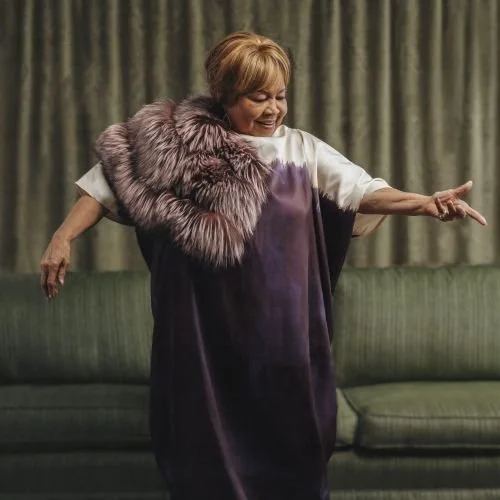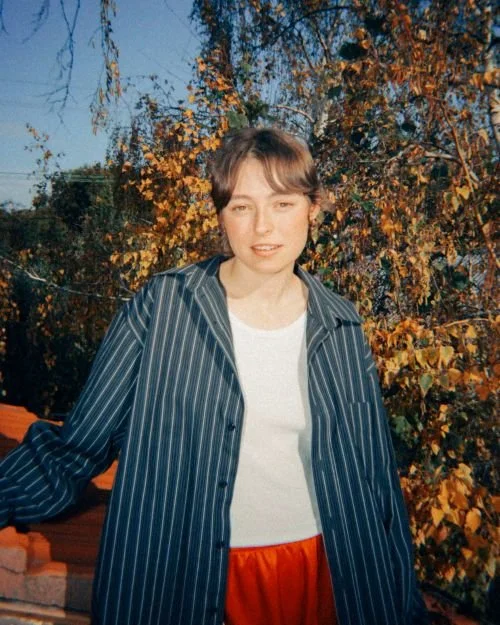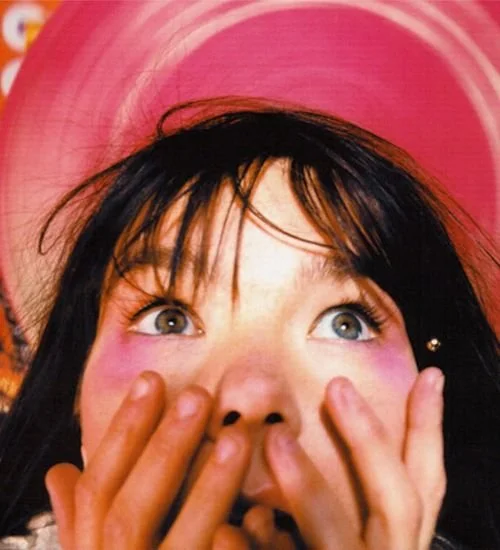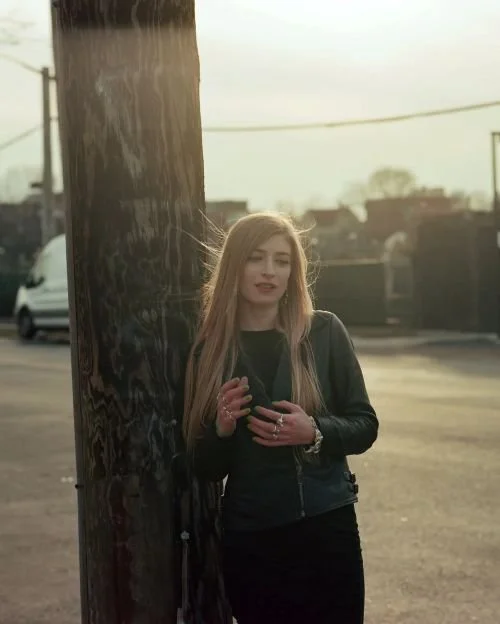FEATURE:
Spotlight
PHOTO CREDIT: Steph Wilson
who I have included I a feature recently, though I have not spotlighted her yet. Oklou (Marylou Mayniel) released her debut studio album, choke enough, earlier in the year. Despite the fact that she has been recording music for over a decade, I do think that now is a time when Oklou is getting a lot more attention and reaching new people. I am going to get to some recent interviews with her. Even though I am not keen on the format of this one from Stereogum - rather than it being a string of questions and answers, it is a bit random and hard to make sense of as there are questions and answers and headers and answers - there is some interesting information that I want to include:
“From the art she puts out as Oklou, it’d be easy to imagine Marylou Mayniel as a forest nymph casting surreal enchantments on classic pop songs or a cupid studying romance’s metamorphosis. She embodied the former, alongside collaborator Casey MQ, while making 2017’s For The Beasts EP, and the latter on 2020’s Galore mixtape. In between, she released 2018’s The Rite Of May EP, a holographic fusion of found sound, trip-hop, classical, and daydreamy synth-pop. It’s no surprise she’s opened for fellow pop folklorist Caroline Polachek and worked alongside innovative artists from NUXXE Collective and PC Music. Each adventure has further solidified her as a modern day mythmaker, conjuring a new realm with experimental electronic and pop music.
On her debut, Mayniel masters playfulness with looming unease. “Forces in everything/ Speak louder than me,” she earnestly sings during the chorus on “Obvious.” Over cherubic horns and a reggaeton-inspired beat, she watches flowers grow and submits to the greater powers at play that feel beyond human comprehension. It exemplifies how Choke Enough feels simultaneously like the manic spiral of an existential crisis and opening a small door to another world that you discovered in the back of a closet, while spring-cleaning.
I’m curious about the differences in escapism of what you’re exploring on Choke Enough versus Galore?
OKLOU: Yeah, the two are totally different. There’s been this need for me in these recent years, without even talking about music, to get closer to real life and what’s happening around me. I don’t know how much of it’s related to me growing up or or also just a post-Galore effect. Because indeed, as you said, Galore, the story that I wanted to tell [she makes a soaring sound] I had to go very far in the universe. I enjoyed it, but I choose to tell the story in a certain way. I was like, Okay, I want to tell this story in the most beautiful way I can even if some aspect of the experience I’m relating to is not beautiful at all. So I have this like a hyper-romantic prism on what I had experienced at the time in the context of a relationship.
Then after that, my life changed. I met someone new as well. My focus changed. The conversations with my friends also changed. It felt like a new movement, a new way to look at things and to get involved in things. It impacted me a lot, especially on my capacity to use my imagination. I was a bit torn actually, because I was so interested in these real life subjects, sometimes very political as well. And then I was going to the studio, and I was like, “Oh yeah, let’s make magic.’ It’s really hard when you think about real life stuff.
It could be easy, I guess, sometimes to actually use art in that regard. But I find it hard for myself to disconnect and reconnect and disconnect. I chose to stay connected to my social life and spiritual, not in the way of beliefs, but what was interesting to me.
It resulted in hours of discussions with Casey, which is my main collaborator. Hours of discussion. It was almost funny, because at some point for each track we’re talking about the concept of the lyrics, etc, for like an hour, two hours, and then at the end of the conversation, we were almost systematically in a dead end of the conversation. We were turning in circles, provoking questions and realizing that there’s no answer at all. [Laughs] So that was really special. It was actually kind of tiring. It’s what happened. It’s really part of the creative process. So it’s, I think, relevant to mention.
How did thoughts on motherhood and family impact the conceptualization of the album?
OKLOU: As far as the thoughts on motherhood, when I wrote the lyrics to “family and friends,” first of all the pregnancy was a total surprise. I had the album to release and the tour to do.
It’s a different kind of birth.
OKLOU: Exactly. But my evocation of motherhood in the context of “family and friends” illustrates, in my opinion, the moments where I’ve been thinking about, why do I feel like I’m necessarily gonna have kids one day? I think, like a lot of women, our age and our generation, are asking themselves these questions — what do I really want to experience? I’ve been growing up in a family where every woman is a mother, and there’s no question about that. And every father is doing the barbecue on Sunday. You know, everything is very like women and men and family driven. It’s great, because my family is good people, and everybody’s saying I have this chance to have a functional [family] having grown up in a functional and loving environment.
But what was not there though was questioning everybody’s posture in the family. I think I’ve become more and more aware of how conditioned we were as women in my family.
It’s been a few years that there’s been this pretty natural conversation in myself regarding the path I want to take in my life, and how much I actually want to be a mother just because all these women before me have done that.
“family and friends,” the chorus is me wondering if it’s even worth asking myself all of these questions. It’s very schizophrenic in that sense. I keep going back and forth between thinking too much if I feel good and enjoying my life as it is, how much you know you have to put yourself in this discomfort of actually questioning everything. What good does that really make for yourself and for people around you?
Your relationship with time is more about marinating and incubating ideas? Or is that delay in a project about perfectionism, wanting to have something fully realized before you put it out?
OKLOU: This is very important, actually, because it’s something also that is dysfunctional, in my opinion, within the industry and what you’re being asked to do. There is so much content, so much information, and so many things being shared. Often I find myself like, I really want this thing that I share to be worth it, to be beautiful, to be incarnated, because I feel, especially in hard times, it’s overwhelming, and things are being shared for the wrong reasons. Many things that are not actually art-focused enough. For me, it’s a shame. I feel bad when I do things in that regard, to run after a result. It’s incompatible with the concept of the industry, obviously, but it’s what’s been at stake recently for me. It’s all about the choices you make at the end of the day”.
I am going to move to an interview from FADER. Oklou’s latest album might be her best asnd most personal. Answering life’s big questions on choke enough, I do wonder how she follows this album. Such an accomplished work, choke enough is one of the best albums of this year. One that everyone should listen to:
“Was starting a family something you'd generally been thinking about?
It's not so much about starting a family, but [the song] definitely holds thoughts around the options that are being presented to me as a human being, as a woman, as an artist. It holds a lot of questioning. I start the song by talking about a very precise memory I have of a conversation with a teacher that was around what you wanna do in life and what you're supposed to do in life and what it means to use your qualities. I use this as a jumping off point for the rest of the track.
When you get older, these questions you asked yourself when you were younger gain so much more weight.
To be fair, my spirit when I was younger felt more free from these questions than these last few years for me. I felt more the weight of these options recently in my life, than when I was 19. After my last project, which was emotionally draining, very intense, very focused, very precise, there's many things in my life that have changed. I think for a natural reason just because I'm a growing up human. But, eventually I had to write lyrics and I can only talk about my life. So if my experiences are the inspiration, what is my experience at this moment? I was trying to answer that question in this album.
Are you listening to classical music often?
I have to admit ever since I started working on the album, I've been listening to very few music actually. There's one playlist I've been listening to on Spotify which is mainly just '70s music of Japanese composers doing new age stuff. I really like that.
How did you know you wanted Bladee to be on the record?
It's been a while actually that I wanted to do something with either him or Ecco2K, who I've been a big fan of also for a while. We actually met a few times and you know, quick exchanges, "Ah, we can do something together." When I was writing the album in Los Angeles, [Casey MQ and I] we went to see a show of Drain Gang. I was really touched by the commitment of the fans. I think it gave me the impulse to actually write to [Bladee and Ecco2k]. But Benjamin was the one to answer my proposition.
What's coming up for you this year? Obviously you have this other project you're working on…
Two releases this year! [laughs] Well, the album is the first big thing which I'm very excited about. And then [I’ll] focus on how I'm gonna share this music with people. I work with a stylist, his name is Pierre, and we've been working on my character for this new album. I think I wanted to get back to something a bit more real in the aesthetic than what I've been exploring in these last years. [Galore] was really fantastic and witchy. I need to get back on Earth a little bit, and putting my vision on, “What is actually going on?” I'm [in my] 30s”.
Last month, Pitchfork spoke with Oklou around the release of the Deluxe Edition of choke enough. They note how “In the afterglow of her magnificent album, choke enough, and the birth of her first child, Marylou Mayniel decamps to the southwest of France”. If you have not heard Oklou and her incredible music, then make sure that you listen to her now, as she is simply phenomenal:
“Mayniel and her elder brother, Clovis, each played piano from a young age; she remembers hearing him practice while she played Barbies, and going to her first lessons at a local music teacher’s home. “She used to have animals in the garden,” she says. Later, she studied cello and piano at conservatory school, and taught herself to play her brother’s guitar with tab sheets printed from the internet. (The siblings also have two older half-sisters.) As a teenager in Poitiers, Mayniel gravitated to Le Confort Moderne, part of a network of government-supported cultural venues called SMAC (scène de musiques actuelles), where she met like-minded friends and saw touring bands perform—memorably, the obliteratingly loud Sunn O))).
Around 2013 she began recording and uploading music of her own, much of which remains online: a beat tape, Avril, and assorted features on chill-out house tracks credited to her old alias, Loumar; a SoundCloud account under Avril Alvarez, a pseudonym based on her birth month, April. In 2014 she moved to Paris, where she became a founding member of a women’s DJ crew, These Girls Are on Fiyah. This is the period when the Oklou discography properly begins, with For the Beasts, and a second EP, The Rite of May, released in 2018, during what became a two-year stay in London, where Mayniel collaborated with the artist Malibu, along with NUXXE collective cofounders Sega Bodega and Shygirl.
A lot of artists in her position, I point out, would’ve wiped their early 2010s internet presence by now. “I just love archives,” she replies. “And I could put it private, but….” She trails off to reflect. “I don’t see why I should take it [down]. Some of it is not good, but it’s normal. It’s part of the process. I’m not ashamed of it.” The matter-of-fact rebuff feels very French, very Oklou.
Unlike Galore, much of which can be played on piano—the song “rosebud” is “literally like a Bach style”—Mayniel perceives choke enough as being synthetic. She rooted her concept of each track in the sonorities of a particular synth chord. “The sound I used to start the creation is gonna tell me which notes I should play, you know?” she explains. “When I play from a guitar or piano, the sound is really always the same, and it’s a great sound, but I’m interested in the texture of sounds that I cannot just stick to.”
She also reoriented her production style around loops, editing and resurfacing sounds and rhythms culled from her files, from Casey’s files, and from professional beat packs until nearly every song developed its own collection of character motifs. The first sound on the album is a lonely, irregular pulse, like a line of Morse code: a drum pattern that she filtered almost beyond recognition. “Me and her both have a similar kind of relationship to drums,” explains Harle, “which is like, we’d prefer them to not be there, but if they have to be there, they might as well have a note in them.” (He hints they have a heap of unreleased work together, including one new song coming soon.)
Mayniel’s favorite choke enough song, coproduced with Casey MQ and another friend, French DJ Lucien Krampf, is the title track. She landed on the word choke, she explains, in the same way as many of her lyrics, which she writes in English: based on the gibberish syllables she invents to model melodies on demos. The rest of the song was harder, because its muted hybrid of pop and electronic conventions doesn’t build up or drop; instead it scrolls by, like a video game background. “I struggled a lot making my point” with the production, she says. “I knew that I didn’t want to take that path of like, club music, but also without saying too much, I was kind of being pressured by people I worked with, being like, Oh, you should…. I was questioning my intuition: Oh, maybe I’m wasting the potential of the track. And so it took me years before I finally felt confident enough to be like, No, I should just follow my gut.”
True Panther’s Bein recalls a point about a year and a half into the recording process, when, conscious of passing time, he asked Mayniel how the label could help her get the songs finished. “She said, ‘You know, for me, in order to finish this, I have to reach a level of loneliness that is really difficult for me to summon, and I don’t actually know when it is that I’m gonna summon it,’ ” he recalls. The album took another year, but Mayniel tells me later that she’s not sure she found true loneliness; eventually, she just had to call it.
Part of why choke enough feels so uncannily familiar, I believe, is that it succeeds at bringing real-life existentialism into the paradoxical condition of feeling permanently online. “Obsessed with living in the present,” Underscores mutters on “harvest sky,” a song inspired by Mayniel’s memories of bonfire celebrations for la Fête de la Saint-Jean, the feast of Saint John the Baptist, which traditionally falls around the summer solstice. What else but the loop, the complete cycle, the refresh, to take us back to ourselves?
Yet if you don’t know what to look for, each song is a sleek, self-contained whole; like Apple used to boast of its tech products, “it just works,” straight out of the box. Months later, I’m still unlocking new features: foggy background samples, pregnant pauses, birdlike screeches that underline the drama of the moment, in much the same way, I notice, as the birds in The Plague Dogs, the film.
These birds were never real, though. The keening tone heard on an interlude, and again on “forces,” is man-made, some kind of equipment that Mayniel recorded in her neighborhood. And “blade bird,” choke enough’s elegiac, acoustic closer, adapts the concept of a Basque-language poem and folk song, “Txoria Txori” (“The Bird’s a Bird”), which laments a love that cannot be possessed. Mayniel first encountered the poem in a novel, Les Gens de Bilbao Naissent Où Ils Veulent, by Spanish writer and filmmaker María Larrea. “When I read the translation, it really resonated a lot with me, and I guess with the history of my parents,” she says.
“I thought it was beautifully placed, that feeling of falling in love with people because they’re beautiful, because they’re so free, but then they’re so free that you can’t have them, really.” At first I pictured a little bird pierced by a dagger, like a traditional tattoo, but months later, I pictured a bird made of blades, wings cycling like the thin, muscular arms of a wind turbine—a loop.
In the back rooms of the internet there used to be all kinds of amateur splendor: hand-curated YouTube music channels, niche Tumblr art archives, strangers’ Flickr galleries, pseudonymous SoundClouds. The underground pop of the 2010s used to get so excited about being online, using shrinky-dink artifice to delight in poking fun at a culture that could feel shallow and strange but also organic and endlessly renewable. Turns out the internet isn’t really forever. Mayniel spends less time on all forms of social media these days: “I’m bored. I don’t know how to use it anymore.” Touch grass, they say: choke enough is an online album looking for the ground.
The ground looks a little different under each of us. A week later, I call Mayniel back to check some details and get a glimpse of hers: Home in a comfy chair, holding baby Zakaria, who’s nursing while Mayniel talks. The heat wave’s finally broken, and the sun’s shining in”.
The French musician has been releasing music for years now, though I thought it was the right time to spotlight her. Oklou is hitting a peak at the moment and she is not widely known. Not in the U.K. anyway. One of these artists who will continue to grow and put out amazing albums, go and follow Oklou. She is someone who is not going away…
ANYTIME soon.
______________
Follow Oklou
PHOTO CREDIT: Gil Gharbi
Official:
Instagram:
https://www.instagram.com/oklou_/
Twitter:
TikTok:
https://www.tiktok.com/@oklou__
Spotify:
https://open.spotify.com/artist/6fFcUOFcbjeIuEomuUthkw?si=GSiNpIxlRkCGakJlso1Faw
YouTube:
https://www.youtube.com/channel/UCPmfaXPGbC03r30Q5eR5atw
Facebook:



































































